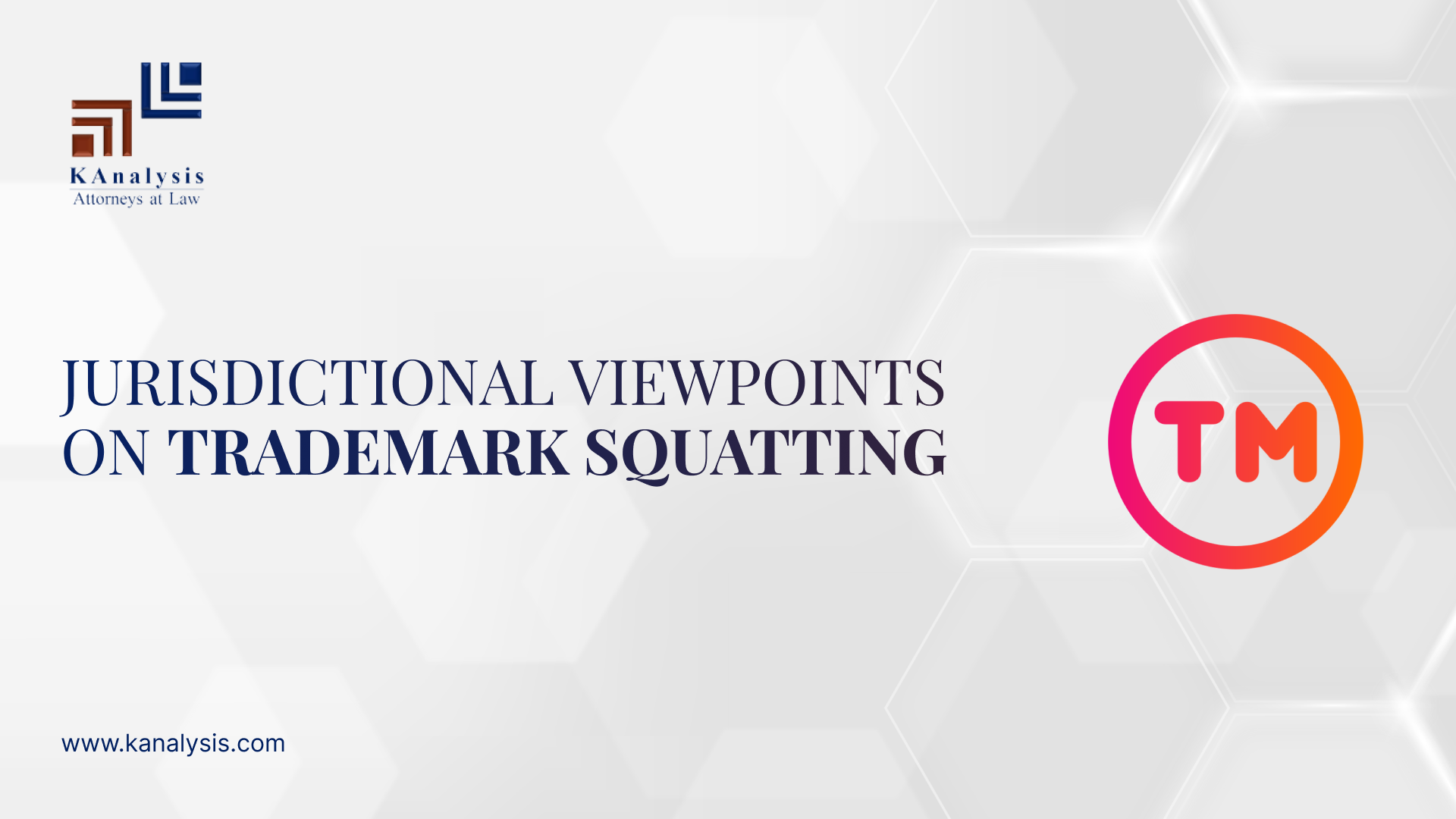The principle of territoriality was recognized in the Paris Convention Article 6(3) of the Paris Convention[1]. This principle gives protection to a trademark within the territory of the state where it has been registered or used this protection gives rise to the problem of ‘trademark squatting’. The World Intellectual Property Organisation (“WIPO”) defines Trademark Piracy or Squatting as “the registration or use of a generally well-known foreign trademark that is not registered in the country or is invalid as a result of non-use[2].“ Thus, trademark squatting occurs when in the foreign country the already registered trademark of the true owner in the original country is registered. This creates a barrier for the original companies to enter that country and thereby, have to pay hefty amounts to stop the use of that infringing trademark. This could be understood by an example–
If a mark has been registered in India then it cannot enforce its trademark rights in China. The owner of an Indian mark has no right to use that mark in a foreign country or to prevent others from using or registering it. If the owner has to exercise these rights in China then he has to specifically register it there under their trademark law.
CHALLENGES POSED BY SQUATTING
- The intention of squatters behind registering such trademarks is not to use these for commerce but to extract rents from the brand owners, importers etc. They wait until the foreign brand they already registered enters the local market so that they can threaten them to sue for infringement.
In the case of Starbucks, they had to enter into a legal proceeding against a Russian national who had registered the trademark Starbucks in Russia to secure its entry into Russia. The legal proceeding substantially delayed Starbucks’s entry into the Russian market.
- The brand owner may try to get to the IP office or civil court to cancel the trademark of squatter, but this process is costly, time taking and uncertain. Thus, brand owners may be willing to pay squatter for abandoning, reassigning or licensing trademark.
A Chinese company, Shenzen Proview Technology registered the trademark IPAD in China in 2012 as a result Apple Inc. faced difficulties involving its marks ‘IPAD’ in China. The company has to pay US $ 60 million to settle the dispute.
- Trademark squatters may also use the trademark to market products or services while free-riding on the brand reputation. This may dilute the original brand and result in forgone sales if the squatter markets similar products under the brand name as the original brand owner.
In India, Sony had to delay the launch of PlayStation 5 or PS5 because of the trademark application filed by a squatter for’PS5’ in a similar specification of goods. Though on the opposition proceedings filed by Sony, the application was withdrawn.
- Many MNCs like Nike, Adidas, and McDonald’s winded up their business in Russia owing to sanctions put on it amidst Ukraine and Russia tension. Thus, the Government of Russia passed a decree allowing locals to adopt and use well-known trademarks for their identical goods or services without paying any royalty or fee. This step legalized the theft of intellectual property and the squatting of many well-known trademarks.
ACQUISITION OF TRADEMARK OWNERSHIP
Trademark squatting revolves around two different approaches which are as follows-
First to Use: This approach is concerned with the fact that if a squatter is not the first one to use the trademark, then he has no authority over the trademark. Even though the squatter is the first user of trademark in a particular country, the proprietor can provide proof of much earlier use of his trademark in some other country and bad faith on the part of the squatter. First to File: The ownership of the trademark under this approach is determined by the one who filed it first. It gets very difficult in such a case for a company to get back the trademark, as the squatter registering first would be favoured over the proprietor. It would be cumbersome for companies to expand their businesses in such a country without registering a trademark.
INDIA’S STAND ON TRADEMARK SQUATTING
India is highly protective towards trademarks and thereby not follows the ‘first to use’ approach but also has formally recognized the concept of a well-known trademark under the Trade Marks Act, of 1999. Such trademarks are accorded protection even in disparate goods and services. The High Court of Delhi in the case of Hengst SE & Anr. v. Tejmeet Singh Sethi & Anr CS (COMM) 600/2021 & I.A. 15381/2021, passed an order against the Defendants indulging in the hoarding several well-known marks of different entities. The Court observed that the Defendants indulged in squatting of a total of 378 well-known marks of different entities and were imposed with a cost of INR 10 lakh that was to be paid to the counsel of the Plaintiffs in a time-bound manner.
The trans-border reputation rule is also followed in India, which upholds the reputation of the brands who though do not have operations in India, but the concept is applied differently in different cases and might not be the sole basis to grant the relief.
INTERNATIONAL PERSPECTIVE
Some of the many countries that follow the First to Use approach include the United States, Singapore, New Zealand, Australia, India, and Canada. It helps in combating the problem of squatting in a much better way than first to file approach.European Union (EU) andChina follow first to file approach that has made the country a hotspot for trademark squatters. However, in Europe, there are many specifications for recognizing the goodwill of the entity that files the trademark application and recognizing it as the legal owner. In the US, there is an Intent to Use filing system which trademark squatters can take advantage of. However, it follows first to use the system and has strong court system protection in place.
HOW TO PREVENT TRADEMARK SQUATTING
- Early registration- The easiest way to prevent trademark squatting is to register the trademark as early as possible in the countries following first to file approach.
- Leverage the Madrid Protocol- The Madrid Protocol is an international system that allows you to obtain trademark protection in 112 member countries with just one single application. Once the trademark is granted through the WIPO, it is registered and recognized in all the member countries.
- Protect transliterations too- Registering your brand name as a trademark can be more difficult in multilingual or non-English speaking countries, thus, it is important to protect transliterations too. Example – Chinese company trademarked ‘Qiaodon’ which is a Chinese transliteration of ‘Jordan’, inspired by the NBA player Michael Jordan. After 8 long years, the Court decided in favour of the player awarding him damages as well. However, still, despite innumerable lawsuits, the player does not have complete trademark rights over his name in China.
- Monitor the use of trademarks worldwide- It’s important to constantly monitor any kind of trademark infringements to ensure no one is using your trademark in any capacity. Thus, it is important to have a robust trademarks watch system.
REMEDIES
Trademark squatting may be considered trademark infringement if real trademark owners can prove that their mark is a prior-used, well-known trademark and is registered in bad faith by the squatter. These are ways to oppose and cancel the trademark of the squatter and get protection for a real trademark. Further, WIPO Arbitration is another efficient way to resolve a dispute than opting for filing a lawsuit in a foreign country. The main function of the WIPO Arbitration and Mediation Center is to facilitate the resolution of intellectual property and related disputes through private procedures as an alternative to court litigation. Further, it provides services to meet the needs for quick and inexpensive ways of settling commercial disputes. Effective trademark-watching services as well as managing the trademark portfolio helps in identifying the squatters and taking action against them at the nascent stage.
CONCLUSION
Trademark squatting is becoming a concerning issue in global business. Mostly, trademark squatting occurs in civil law countries where first to file approach is prevalent. Trademark squatting disputes can most be fairly and efficiently resolved by WIPO arbitration. The laws in India are forward-looking however, the burden of proving a trademark is well-known and existent in the country is on the owner. As well as the backlog of cases and extremely long legal battles in the courts lead to slow and ineffective enforcement strategies. India is progressing but still, there is a need for measures to solve these kinds of disputes timely. There are many other countries like China, and Russia where trademark squatting is on a high-rise. Thus, common practices should be adopted by the countries to stand together against the trademark squatters.
[1] Paris Convention for the Protection of Intellectual Property, art. 6, Mar. 20, 1883, 21. U.S.T. 1583 (revised July 14, 1967), n“Marks: Conditions of Registration; Independence of Protection of Same Mark in Different Countries.
[2] WORLD INTELL. PROP. ORG., WIPO INTELLECTUAL PROPERTY HANDBOOK, 90 (2008).
Subscribe to our monthly newsletter here and read all our blogs here



